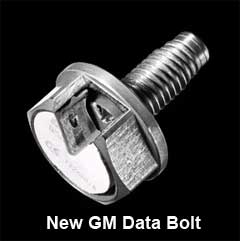From SCDigest's OnTarget e-Magazine
- Jan. 7, 2014 -
RFID News Round-Up for Week of Jan. 7, 2014
GM Utilizes Smart Bolts in Engine Assemblies - but Why? Whirlpool RFID Parts Tracking a No Brainer; Tesco Moving to Item-Level in Apparal, but Wants Other Sensors Too
SCDigest Editorial Staff
Below are the top RFID-related that caught our eye over the past week.
GM Using Smart Bolts
In its assembly factory in Tonawanda, N.Y., GM is now using engine bolts with RFID chips and antennas inside, embedded in a cavity in the head of the fastener.
SCDigest Says: |
 |
Even simple and seemingly obvious solutions such as the one Whirlpool adopted have seen some resistance in manufacturing due to concerns over read issues or durability in a harsh factory environment,
|
|
What Do You Say?
|
|
|
|
GM calls these "data bolts," and their purpose is to record what happens during the complex process of assembling the engine block and cylinder heads. One data bolt is placed on both the engine block and the cylinder head at the beginning of the assembly process.
There are about 50 different points throughout the production line where data gets transferred to and from the bolts. Just about every automated machine on the line has an RFID scanner to read the data bolt before it performs its task, and another RFID writer that logs new information onto the bolt once the machine has done its job. If any of the machines on the floor do not complete their duties to perfection, the next machine in line will identify that error and shunt any out-of-spec engine block or cylinder head off the line to be inspected by a worker.
Once the cylinder heads are fully milled, they're attached to the block using a machine that screws down all 20 bolts at the same time. Here again, the RFID tracking is used, allowing workers to tell whether each bolt was successfully installed.
When assembly is completed, the two bolts are removed and re-used.
The original article in Popular Mechanics does not make it clear what the added value is of the RFID bolts, meaning this: It may of course make sense to uniquely identify with an RFID tag a specific engine or components of the engine. But why does the system need to read and write production data to the tags? Why not simply update the manufacturing software system with this data, tied to the RFID serial number?
In fact, the article says that "All of the data from each bolt gets uploaded to servers housed at the factory."
Logic would say the answer is the smart bolts could perhaps allow the system to keep working in the event the main software system goes down, but there are problems with that theory too, as in such a scenario all that might be done is to write data to the tags on steps performed, since the system that confirms the correct steps have been performed would be down.
 SCDigest would welcome reader theories on this question. SCDigest would welcome reader theories on this question.
Whirlpool Move to RFID for Parts Tracking a No Brainer
Whatever you think about RFID generally, or in consumer goods and retail applications, there are some scenarios where SCDigest believes it is just a no brainer.
Take Whirlpool, the world's leading appliance maker. In its massive Clyde , OH plant, it appears until recently that tracking of racks containing painted parts were identified with a basic paper tag system. Yes, that approach being used 13 years into the 21st century.
Needless to say, the tags often become lost or unreadable or were misread by fork truck drivers, causing data errors. The manual, paper-based tracking system was so poor that Whirlpool had to perform three daily audits at a great time and cost to ensure sufficient level s of inventory accuracy.
Whirlpool considered a bar code tracking system, but says the modest cost of the labels (about 4.5 cents each) was something of a barrier.
Regardless, the company went with a basic RFID tracking system, where RFID chips are attached to the re-usable racks. These are large tags that have a display to provide information to fork truck drivers.
Readers were installed in the ceiling, with antennas located closer to where the forklifts would be shuttling racks. A Whirlpool manager says that the hardest part of the implementation was running Ethernet cable around the plant to accommodate all the receiving stations.
(RFID and AIDC Story Continued Below)
|